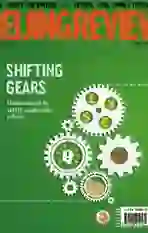IRONING OUT DIFFICULTIES
2016-04-08ByMaXiaowen
By+Ma+Xiaowen
Chinas iron and steel industry is shackled by problems derived from excess production capacity over the past years, triggering a plunge in the price of steel.
“[Overproduction in the industry] is a widely known fact,” said Ma Guoqiang, head of the China Iron and Steel Association and President of the Wuhan Iron and Steel (Group) Corp. (WISCO), in an interview by the website of Peoples Daily. Ma added that the surplus in production was a result of the fast growth that both the global and domestic economies had witnessed in previous years. During the heydays of economic growth, the industry had to keep up with the growing demand on raw materials such as iron and steel, which led to decisions to expand capacity.
In the iron and steel industry, the supplyside reform will deal with a reduction in excess production capacity which has failed to meet demand, according to Ma. “The reform will then attempt to recalibrate those means of production with the current demand and industry structure,” he added.
At the same interview, Cheng Bingqiang, President of metallurgical giant China MCC5 Group Corp. Ltd., stressed that the core concept behind the supply-side reform is to make products meet the needs of society and the market.
“Our steel enterprises still have a lot to do to upgrade their products,” Cheng said. “During the supply-side reform, we need to combine capacity reduction measures with structure adjustment and overseas market expansion.”
Ma believed that steel companies need to seek innovation to create new demand for steel products while slashing production costs.
Chen Ziqi, Deputy Director of the Metallurgy and Building Materials Department at the China International Engineering Consulting Corp., agreed, saying that the iron and steel industry needs to promote product upgrading through three main methods.
First, steelmakers should produce high value-added, high-end products themselves instead of relying on imported products.
Next, they should develop high-performance products that meet the needs of the upgrades occurring in downstream sectors.
Finally, they should also promote the use of their upgraded steel structures in the construction of future buildings.
Cost reduction, Chen said, is a permanent task for companies, although lowering costs in the iron and steel industry cant fully offset the decline in prices. Meanwhile, the government is expected to take measures to reduce transaction costs, tax and fee burdens, financial costs, electricity prices and logistics costs for companies.
Chinas iron and steel industry, unlike some developed countries, has a low degree of industrial concentration. “We have over 1,500 large and medium-sized steel enterprises whose policy-making has been individually conducted based on their own judgment, which has led to overcapacity,” said Ma. “Under this current situation, reorganization has become an irresistible trend.”
The largest obstacle will be the proper arrangement of staff, according to Ma. Cheng also said that companies need to properly handle staff resettlement.
“As a state-owned enterprise, WISCO carries the responsibility of relocating its staff,”said Ma. WISCO is the countrys first super-large state-owned iron and steel complex, whose construction began in 1955 and was put into production in 1958. The company is facing a relocation of more than half of its 80,000 employees.
Its estimated that 10 million people in the labor force will be laid off during the supplyside reform. Preliminary statistics show that 1.8 million employees will be made redundant in the coal and steel industries, which form the first step to reduce capacity.
Ma introduced three methods that WISCO has employed to handle the issue: First, those who will reach their legal retirement age in five years without the ability or desire to work can leave for their retirement. Second, the state-owned company has already diversified its businesses and transferred some staff to affiliated non-steel companies. Third, WISCO is working with local government and companies to help its staff find new jobs.
